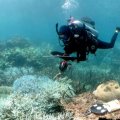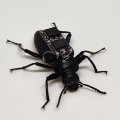The $105 million Queensland Bioscience Precinct is an important example of the type of synergy and leverage that can be achieved by different groups working together, according to UQ Vice-Chancellor and Chair of the Group of Eight universities, Professor John Hay.
The Precinct, which will house 700 scientists from UQ’s Institute for Molecular Bioscience, CSIRO and Queensland Department of Primary Industries, will open on May 21.
Professor Hay was addressing a National Press Club forum on technology transfer in Canberra yesterday, which helped launch the 2003 Australian Innovation Festival. The forum also featured addresses from the Chief Scientist of the Commonwealth, Dr Robin Batterham, and The Business Council of Australia`s Chief Economist Melinda Cilento.
Professor Hay said UQ was the first to commit to the project, which received bipartisan support including $15 million from the Commonwealth’s Federation Fund, $15 million from the Queensland Government (followed by a further $80 million over 10 years), $50 million from CSIRO, and $10 million from an American philanthropist, but none from Australian business.
“What these sums of money did was put an infrastructure in place. What the university did was identify what its priorities were and how they would conform to national and international priorities,” Professor Hay said.
“The collaboration among CSIRO and the university, among state and federal authorities presumes that the university took the hard decisions in identifying where its strengths and critical masses were, and decided to remove sources of funding from less well performing areas and reallocated them to areas of high potential and high performance.
“The need to collaborate with our sister universities was manifest. Before this project began The University of Queensland and University of Melbourne were collaborating partners in the Australian Genome Research Facility, a Major Nation Research Facility that undertakes DNA sequencing and genetic analysis for the Australian research community.
“If you can put a critical mass together and fund an infrastructure from a variety of sources you should also be looking at the next infrastructures, the next critical masses, so they don`t, indeed, fail to overlap. You get that appropriate creative symbiosis between them.
“So, at the time we`re opening the Institute of Molecular Bioscience and the Queensland Bioscience Precinct, we will be commencing building on the Australian Institute of Bioengineering and Nanotechnology (AIBN) with similar sources of funding, but none yet from the Federal Government.”
Professor Hay leaves for the United States today to try to secure further funding for the successor project to the AIBN.
He said one infrastructure was not enough. One critical mass was not enough.
“It is appropriate to build an interlocking series of masses both critical and physical. Universities are doing this in tough times and we have to because it is what our competitor nations are doing”
Professor Hay said all of Australia’s universities could not be research-intensive, and they had to differentiate themselves at what they did best. Success in competing for competitive research funding should have the consequence of that research being fully funded and the infrastructure being appropriately maintained.
He urged caution in assessing potential returns which might flow from commercial activities of universities.
“Research commercialisation can at best generate about three to five per cent of a university`s revenue,” he said.
“Neither government nor universities should pursue research commercialisation solely or primarily as a major source of revenue.
“But the direct and indirect results for the rest of the economy and community are of a far greater order.”
Professor Hay acknowledged the spectacular success of The University of Queensland’s technology transfer company, UniQuest and Uniseed, a joint commercialisation activity of The University of Queensland and the University of Melbourne.
He backed a call by Dr Batterham for a smaller number of mega specialist university commercialisation units to spearhead commercialisation in the university sector.
“Brendan Nelson recently drew attention to a report which indicated that a group of Australian universities, notably Sydney and Queensland, were performing at international best practice. This was even in comparison with the Americans, in terms of developing patents and commercialised intellectual property and income of a kind up in the top 10 per cent of American universities,” he said.
“That`s a nice claim to be able to make. The magnitude, of course, is greater in the United States than it is here.”
However, he stressed that universities were not businesses, and should not be treated as such by policy makers.
Their roles were the creation of technology, the discovery of knowledge and the delivery of education for the benefit of the wider community. 84 percent of basic research was conducted in Australian universities.
“What the universities and the economy need are support for research commercialisation to have appropriate sums of pre-seed capital, proof of concept funding, prototype development and funds to support adequate IP protection,” he said..
Professor Hay said when he spoke to the National Press Club last year he noted the trend that Australia’s expenditure on research and development as a proportion of gross national product was declining, and had been declining for some years.
It was still the case that Australia was now 0.1 per cent ahead of Slovenia in terms of the proportion of its gross national product spent on research and development.
Media: Further information, Jan King 0413 601 248.
.jpg)


